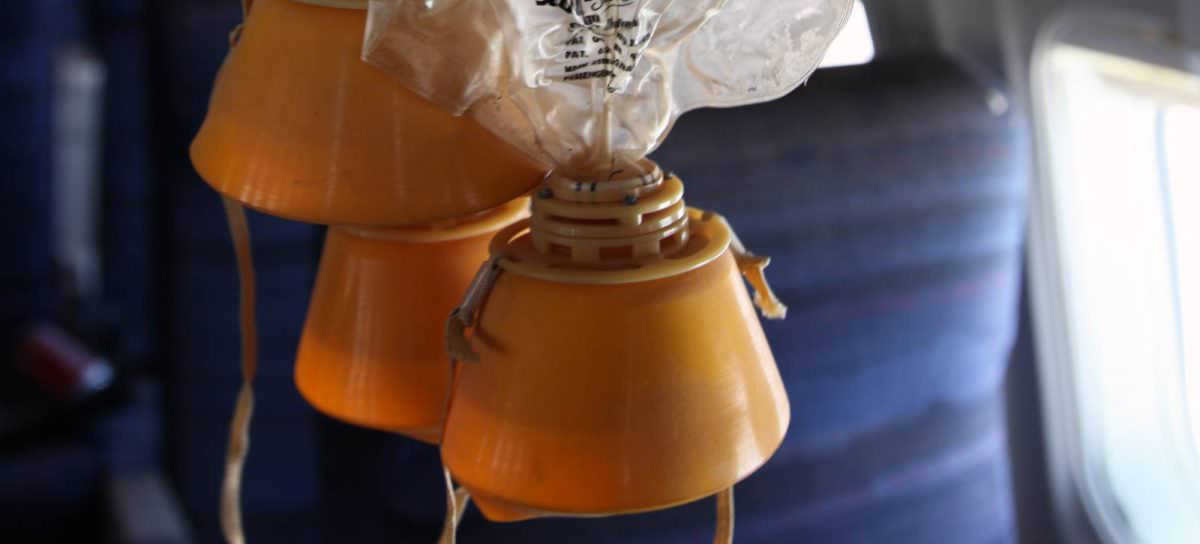Do you really need to wear the oxygen mask if it drops from the ceiling?
It’s pretty safe to assume that just about everyone is familiar with flight attendant safety demonstrations at the start of every flight… “In case there is a loss in cabin pressure, yellow oxygen masks will deploy from the ceiling compartment located above your head…” Well, that’s great, but do you really need to wear those oxygen masks if they drop? Or is the oxygen there just to make people “high” and calm them down?
As an airline pilot, I can tell you that yes, you definitely do need to wear the oxygen masks. If the airplane cabin becomes depressurized, the air in the cabin will not contain enough oxygen for you to remain conscious for very long. The oxygen mask will prevent that from happening. Also, I can assure you that the oxygen is not there to get you “high” or make you delirious. Unfortunately, several movies have promoted a myth about the purpose of the oxygen masks. Most notably, Brad Pitt’s character in “Fight Club” makes the claim that oxygen “gets you high,” and implies that the masks are simply a way to calm everyone during an emergency. This is completely false.
…the oxygen is not there to get you “high” or make you delirious.
The masks are necessary because without a functioning pressurized cabin, the air is usually too thin and contains too little oxygen for your body to function normally. In fact, it’s the lack of oxygen that would cause people to become delirious or appear intoxicated. As altitude increases, the atmosphere contains less and less oxygen, which results in “thinner” air. This means that there is less oxygen for your lungs to process and pass along through the blood stream to the brain and other organs. If the air gets too “thin” the body cannot get enough oxygen to function and your brain and thought processes slow down. So it is actually a lack of oxygen (and not the masks) that can cause people to become slap-happy. The clinical term for this is called hypoxia.
If this trend is allowed to continue, you may eventually pass out. On average, most people don’t start experiencing a degraded ability to think or reason until they are above about 14,000 feet. At this altitude, you will remain conscious and be able to move, but your brain function will begin to diminish. Very few people have ever experienced these effects. And unless you’re planning to climb Mt. Everest, you’ll probably never experience them either.
In contrast, commercial airliners typically fly at altitudes of 30,000 to 40,000 feet. This is way too high for anyone to remain conscious for more than a very short while. As a result, the airplane cabin is pressurized to artificially maintain a much lower altitude. This way the air pressure inside the plane stays at a much more reasonable level (about 5,000 to 7,000 feet), allowing the passengers to breathe comfortably.
During an emergency loss of cabin pressure, it is possible for the cabin altitude to climb rapidly. The amount of oxygen in the air would also diminish quickly. Under these circumstances, without an oxygen mask, the average person would probably pass out after about 20 seconds. While this type of scenario is extremely rare, it highlights why the flight attendants conduct the safety demonstration on every flight. This is also why they direct you to put on your own mask before helping others. If you put the mask on your child or neighbor first, you could potentially pass out before you are able to put on your own mask.
It should be noted that each passenger’s mask also has its own oxygen supply that is certified and designed to last in excess of ten minutes. That will provide more than enough time for the pilots to quickly descend to a safe altitude (where the air is thick enough for everyone to breath normally without the masks).
Again, it’s important to emphasize that pure oxygen does not cause you to become “stoned” or inebriated. Other highly trained professionals like firefighters rely on oxygen masks when they are trying to save people trapped inside burning buildings. Similarly, NFL players can sometimes be seen breathing oxygen on the sidelines. Typically, this is done at high altitude stadiums like Denver to counter the effects of altitude. Obviously, neither firefighters nor pro athletes would ever do anything that would impede them from successfully doing their jobs.
As an airline pilot who has had to use all of the emergency equipment as part of my training, I can assure you that those oxygen masks do not cause you to “get high” or become delirious. They are simply there for your safety and enable you to continue to breathe and function normally during a loss of cabin pressure. Please remember that a rapid loss of cabin pressure is an extremely unlikely event. However, with safety always remaining the top priority, the airlines still plan for every conceivable scenario. The masks are just another way to help you, should the need arise.
